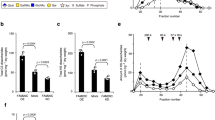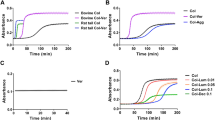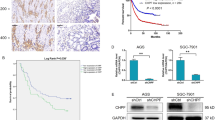Abstract
Arylsulfatase B (N-acetylgalactosamine-4-sulfatase; ARSB) removes 4-sulfate groups from chondroitin-4-sulfate (C4S) and dermatan sulfate and is required for their degradation. In human prostate stromal and epithelial cells, when ARSB was silenced, C4S, versican and versican promoter activity increased, and the galectin-3 that co-immunoprecipitated with C4S declined. Galectin-3 silencing inhibited the ARSB-silencing-induced increases in versican and versican promoter due to effects on the AP-1-binding site in the versican promoter. These findings demonstrate for the first time the transcriptional mechanism whereby ARSB can regulate expression of an extracellular matrix proteoglycan with C4S attachments. In addition, following ARSB silencing, C4S that co-immunoprecipitated with versican increased, whereas co-immunoprecipitated EGFR declined, total EGFR increased and exogenous EGF-induced cell proliferation increased, suggesting profound effects of ARSB on vital cell processes.
This is a preview of subscription content, access via your institution
Access options
Subscribe to this journal
Receive 50 print issues and online access
$259.00 per year
only $5.18 per issue
Buy this article
- Purchase on Springer Link
- Instant access to full article PDF
Prices may be subject to local taxes which are calculated during checkout






Similar content being viewed by others
References
Bhattacharyya S, Solakyildirim K, Zhang Z, Linhardt RJ, Tobacman JK . Cell-bound IL-8 increases in bronchial epithelial cells following Arylsulfatase B silencing. Am J Respir Cell Mol Biol 2010; 42: 51–61.
Prabhu SV, Bhattacharyya S, Guzman-Hartman G, Macias V, Kajdacsy-Balla A, Tobacman JK . Extra-lysosomal localization of arylsulfatase B in human colonic epithelium. J Histochem Cytochem 2011; 59: 328–335.
Feferman L, Bhattacharyya S, Deaton R, Gann P, Guzman G, Kajdacsy-Balla A et al. Potential role of Arylsulfatase B as a biomarker for prostate cancer. Prostate Cancer PD 2013; 16: 277–284.
Mitsunaga-Nakatsubo K, Kusunoki S, Kawakami H, Akasaka K, Akimoto Y . Cell-surface arylsulfatase A and B on sinusoidal endothelial cells, hepatocytes, and Kupffer cells in mammalian livers. Med Mol Morphol 2009; 42: 63–69.
Bhattacharyya S, Solakyildirim K, Zhang Z, Linhardt RJ, Tobacman J . Chloroquine reduces arylsulfatase B activity and increases chondroitin 4-sulfate: Implications for mechanisms of action and resistance. Malaria J 2009; 8: 303.
Bhattacharyya S, Kotlo K, Shukla S, Danziger RS, Tobacman JK . Distinct effects of N-acetylgalactosamine-4-sulfatase and galactose-6-sulfatase expression on chondroitin sulfate. J Biol Chem 2008; 283: 9523–9530.
Bhattacharyya S, Tobacman JK . Arylsulfatase B regulates colonic epithelial cell migration by effects on MMP9 expression and RhoA activation. Clin Exp Metastasis 2009; 26: 535–545.
Bhattacharyya S, Tobacman JK . Steroid sulfatase, arylsulfatases A and B, galactose 6-sulfatase, and iduronate sulfatase in mammary cells and effects of sulfated and non-sulfated estrogens on sulfatase activity. J Steroid Biochem Mol Biol 2007; 103: 20–34.
Wang H, Katagiri Y, McCann TE, Unsworth E, Goldsmith P, Yu ZX et al. Chondroitin-4-sulfation negatively regulates axonal guidance and growth. J Cell Sci 2008; 121: 3083–3091.
Yoo M, Khaled M, Giubbs KM, Kim J, Kowalewski B, Dierks T et al. Arylsulfatase B improves locomotor function after mouse spinal cord injury. PLoS One 2013; 8: e57415.
Ferrero GB, Pagliardini S, Veljkovic A, Porta F, Bena C, Tardivo I et al. In vivo specific reduction of arylsulfatase B enzymatic activity in children with cystic fibrosis. Mol Genet Metab 2008; 94: 39.
Bhattacharyya S, Look D, Tobacman JK . Increased arylsulfatase B activity in cystic fibrosis cells following correction of CFTR. Clin Chim Acta 2007; 380: 122–127.
Sharma G, Burke J, Bhattacharyya S, Sharma N, Katyal S, Park RL et al. Reduced arylsulfatase B activity in leukocytes from cystic fibrosis patients. Pediatr Pulmonol 2013; 48: 236–244.
Bhattacharyya S, Kotlo K, Danziger R, Tobacman JK . Arylsulfatase B regulates interaction of chondroitin-4-sulfate and kininogen in renal epithelial cells. Biochim Biophys Acta 2010; 1802: 472–477.
Kotlo K, Bhattacharyya S, Yang B, Feferman L, Tejaskumar S, Linhardt R et al. Impact of salt exposure on N-acetylgalactosamine-4-sulfatase (Arylsulfatase B) activity, glycosaminoglycans, kininogen, and bradykinin. Glycoconjugate J 2013; 30: 667–676.
Bhattacharyya S, Tobacman JK . Hypoxia reduces arylsulfatase B activity and silencing arylsulfatase B replicates and mediates the effects of hypoxia. PLoS One 2012; 7: e33250.
Iwaki J, Minamisawa T, Tateno H, Kominami J, Suzuki K, Nishi N et al. Desulfated galactosaminoglycans are potential ligands for galectins: evidence from frontal affinity chromatography. Biochem Biophys Res Commun 2008; 373: 206–212.
Song S, Byrd JC, Mazurek N, Liu K, Koo JS, Bresalier RS . Galectin-3 modulates MUC2 mucin expression in human colon cancer cells at the level of transcription via AP-1 activation. Gastroenterology 2005; 129: 1581–1591.
Wang Y, Nangia-Makker P, Tait L, Balan V, Hogan V, Pienta KJ et al. Regulation of prostate cancer progression by galectin-3. Am J Pathol 2009; 174: 1515–1523.
Hann A, Gruner A, Chen Y, Gress TM, Buchholz M . Comprehensive analysis of cellular gaectin-3 reveals no consistent oncogenic function in pancreatic cancer cells. PLoS One 2011; 6: e20859.
Ricciardelli C, Mayne K, Sykes PJ, Wyaymond WA, McCaul K, Marshall VR et al. Elevated stromal chondroitin sulfate glycosaminoglycan predicts progression in early-stage prostate cancer. Clin Cancer Res 1997; 3: 983–992.
Ricciardelli C, Mayne K, Sykes PJ, Raymond WA, McCaul K, Marshall VR et al. Elevated levels of versican but not decorin predict disease progression in early-stage prostate cancer. Clin Cancer Res 1998; 4: 963–971.
Ricciardelli C, Sakko AJ, Ween MP, Russell DL, Horsfall DJ . The biological role and regulation of versican levels in cancer. Cancer Metastasis Rev 2009; 28: 233–245.
Sakko AJ, Ricciardelli C, Mayne K, Suwiwat S, LeBaron RG, Marshall VR et al. Modulation of prostate cancer cell attachment to matrix by versican. Cancer Res 2003; 63: 4786–4791.
Kischel P, Waltregny D, Dumont B, Turtoi A, Greffe Y, Kirsch S et al. Versican overexpression in human breast cancer lesions: known and new isoforms for stromal tumor targeting. Int J Cancer 2010; 126: 640–650.
Domenzain-Reyna C, Hernández D, Miquel-Serra L, Docampo MJ, Badenas C, Fabra A et al. Structure and regulation of the versican promoter: the versican promoter is regulated by AP-1 and TCF transcription factors in invasive human melanoma cells. J Biol Chem 2009; 284: 12306–12317.
Holzberg D, Knight CG, Dittrich-Breiholz O, Schneider H, Dörrie A, Hoffmann E et al. Disruption of the c-JUN-JNK Complex by a cell-permeable peptide containing the c-JUN δ domain induces apoptosis and affects a distinct set of interleukin-1-induced inflammatory genes. J Biol Chem 2003; 278: 40213–40223.
Fanjul A, Dawson MI, Hobbs PD, Jong L, Cameron JF, Harley E et al. A new class of retinoids with selective inhibition of AP-1 inhibits proliferation. Nature 1994; 372: 107–111.
Du WW, Yang BB, Shatseva TA, Yang BL, Deng Z, Shan SW et al. Versican G3 promotes mouse mammary tumor cell growth, migration, and metastasis by influencing EGF receptor signaling. PLoS One 2010; 5: e13828.
Wu Y, Chen L, Cao L, Sheng W, Yang BB . Overexpression of the C-terminal PGM/versican domain impairs growth of tumor cells by intervening in the interaction between epidermal growth factor receptor and beta1-integrin. J Cell Sci 2004; 117: 2227–2237.
Xiang YY, Dong H, Wan Y, Li J, Yee A, Yang BB et al. Versican G3 domain regulates neurite growth and synaptic transmission of hippocampal neurons by activation of epidermal growth factor receptor. J Biol Chem 2006; 281: 19358–19368.
Roeser D, Preusser-Kunze A, Schmidt B, Gasow K, Wittmann JG, Dierks T et al. A general binding mechanism for all human sulfatases by the formylglycine-generating enzyme. Proc Natl Acad Sci USA 2006; 103: 81–86.
Roeser D, Schmidt B, Preusser-Kunze A, Rudolph MG . Probing the oxygen-binding site of the human formylglycine generating enzyme using halide ions. Acta Crystallogr D Biol Crystallogr 2007; 63: 621–627.
Wòjczyk B . Lysosomal arylsulfatases A and B from horse blood leukocytes: purification and physico-chemical properties. Biol Cell 1986; 57: 147–152.
Rao GJ, Christe M . Inhibition of rabbit liver arylsulfatase B by phosphate esters. Biochim Biophys Acta 1994; 788: 58–61.
Christianson TM, Starr CM, Zankel EC . Overexpression of inactive arylsulphatase mutants and in vitro activation by light-dependent oxidation with vanadate. Biochem J 2004; 283: 581–587.
Yoo BC, Hong SH, Ku JL, Kim YH, Shin YK, Jang SG et al. Galectin-3 stabilizes heterogeneous nuclear ribonucleoprotein Q to maintain proliferation of human colon cancer cells. Cell Mol Life Sci 2009; 66: 350–364.
Wang L, Inohara H, Pienta KJ, Raz A . Galectin-3 is a nuclear matrix protein which binds RNA. Biochem Biophys Res Commun 1995; 217: 292–303.
Harmatz P, Giugliani R, Schwartz IV, Guffon N, Teles EL, Miranda MC et alMPS VI Study Group. Enzyme replacement therapy in mucopolysaccharidosis VI (Maroteaux-Lamy syndrome). J Pediatr 2004; 144: 574–580.
Rauscher FJ 3rd, Sambucetti LC, Curran T, Distel RJ, Spiegelman BM . Common DNA binding site for FOS protein complexes and transcription factor AP-1. Cell 1998; 52: 471–480.
Bhattacharyya S, Borthakur A, Dudeja PK, Tobacman JK . Carrageenan induces cell cycle arrest in human intestinal epithelial cells in vitro. J Nutr 2008; 138: 469–475.
Acknowledgements
We acknowledge the contribution of Robert Linhardt, PhD, and Dr Bo Yang, who performed the disaccharide analysis.
Author information
Authors and Affiliations
Corresponding author
Ethics declarations
Competing interests
The authors declare no conflict of interest.
Rights and permissions
About this article
Cite this article
Bhattacharyya, S., Feferman, L. & Tobacman, J. Arylsulfatase B regulates versican expression by galectin-3 and AP-1 mediated transcriptional effects. Oncogene 33, 5467–5476 (2014). https://doi.org/10.1038/onc.2013.483
Received:
Revised:
Accepted:
Published:
Issue Date:
DOI: https://doi.org/10.1038/onc.2013.483
Keywords
This article is cited by
-
The molecular interplay of the establishment of an infection – gene expression of Diaphorina citri gut and Candidatus Liberibacter asiaticus
BMC Genomics (2021)
-
VersicanV1 promotes proliferation and metastasis of hepatocellular carcinoma through the activation of EGFR–PI3K–AKT pathway
Oncogene (2020)
-
Genome-wide identification of genes probably relevant to the adaptation of schizothoracins (Teleostei: Cypriniformes) to the uplift of the Qinghai-Tibet Plateau
BMC Genomics (2017)
-
Restriction of Aerobic Metabolism by Acquired or Innate Arylsulfatase B Deficiency: A New Approach to the Warburg Effect
Scientific Reports (2016)



